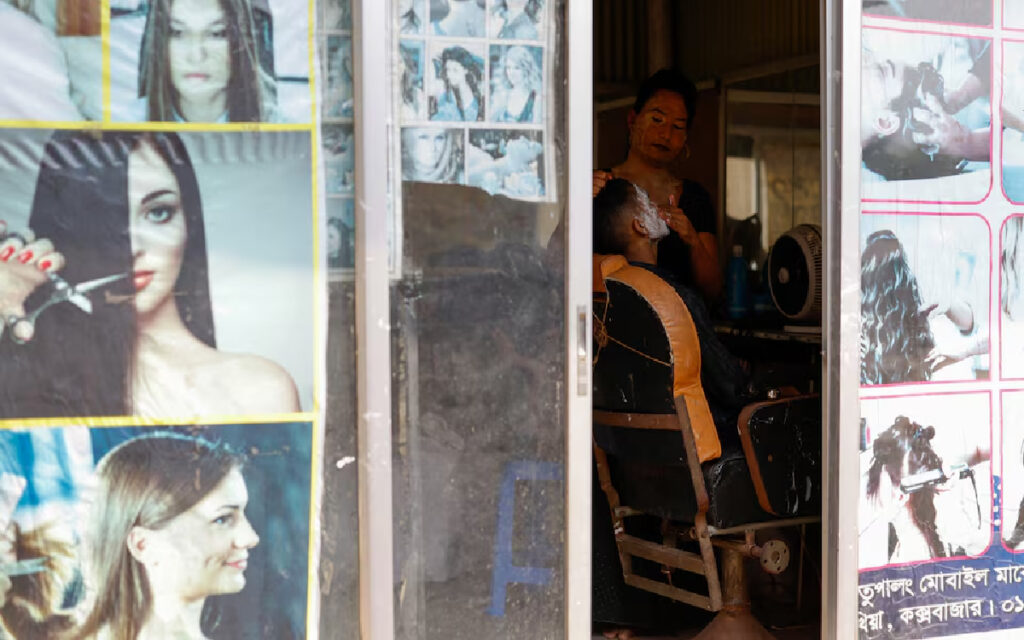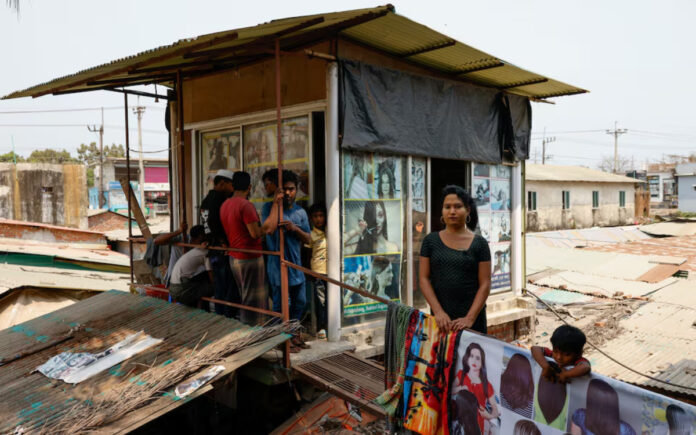Kutupalong Refugee Camp, Bangladesh: In the labyrinth of narrow lanes within the sprawling Rohingya refugee camps in southeastern Bangladesh, Tanya’s small beauty studio is a haven of transformation. With skilled hands, she crafts intricate hairstyles and flawless facials, drawing a steady stream of customers. But beyond the artistry of her makeup lies a deeper struggle—Tanya is a transgender woman in a community that barely acknowledges her existence.
“Being Rohingya is hard,” she said. “But being a transgender Rohingya is even harder.”
At 25, Tanya has endured more than most. She fled Myanmar in 2017 alongside hundreds of thousands of Rohingya Muslims escaping a brutal military crackdown. Life as a refugee is difficult, but for Tanya, the hardship is compounded by the discrimination she faces daily.

A Life Marked by Rejection
Tanya’s journey has been fraught with rejection—even from her own people. The deep-rooted stigma against transgender individuals in her community has cost her dearly.
“I can’t visit my 55-year-old mother anymore,” she said, seated in her modest 10-by-10-foot (three-by-three-meter) salon. “Every time I tried, the neighbors attacked me. They threw water at me, pelted stones, pulled my hair. I couldn’t bear it anymore, so I stopped going.”
Born in Maungdaw, Rakhine State, Tanya knew from an early age that she was different. In the conservative Rohingya society, however, there was no space for someone like her. When her family refused to accept her, she sought solace in the Hijra community—a tight-knit network of transgender individuals who live together for safety and survival. There, she was given the name Tanya by her godmother.

Carving a Path Through Beauty
Officials estimate there are around 10,000 Hijras in Bangladesh, but rights groups suggest the number could be as high as 1.5 million in the country of 170 million. Whether in Myanmar or Bangladesh, transgender individuals often face severe stigma, disownment, and exclusion, forcing many into begging or sex work to survive.
Determined to forge a different path, Tanya honed her skills in makeup and hairstyling while still in Myanmar. Those talents became her lifeline when she arrived in Bangladesh as a refugee.
“I had no job when I came here,” she said. “But I found the owner of this shop and requested him to let me open a beauty parlor. He gave me a chance. Since then, I’ve been working here.”
Today, Tanya earns around 5,000 to 6,000 taka ($45 to $55) per month—enough to sustain herself. Her salon has become popular among both Rohingya refugees and local Bangladeshis, with long queues forming for facials, haircuts, and bridal makeovers.
Yet, outside the confines of her salon, acceptance remains elusive. “Many transgender people like me hide their identity and live as men just to avoid harassment and rejection,” she explained.
In the Kutupalong refugee camp in Bangladesh, Tanya, a transgender Rohingya woman, is seeking her own path as a beautician and training others like her, helping them build a livelihood https://t.co/QUXifVefS3 pic.twitter.com/gHquK0BV7J
— Reuters (@Reuters) March 26, 2025
Also Read | Thai Prime Minister Paetongtarn Shinawatra Survives No-Confidence Challenge
Building a Future
Despite the hardships, Tanya is determined to make a difference. She has trained four other transgender women as beauticians, and they have since found opportunities abroad. She hopes to follow them one day.
“They always call me and tell me to come. I want to go too,” she said. “I dream of opening my own salon and standing on my own feet.”
Her personal ties have largely eroded. She has lost contact with her parents and siblings, some of whom now live in India.
“My parents are alive, but I am dead to them,” she said. “Even the person I loved left me.”
Also Read | Tensions Soar in Beni as Police Fire on Crowds at Delcat Idengo’s Burial
A Fight for Recognition
As International Transgender Day of Visibility approaches, Tanya hopes her story will challenge perceptions and encourage acceptance within the Rohingya community.
“I always tell my community, don’t beg—learn a skill,” she said. “If we work hard, maybe one day people will respect us.”
Her ultimate wish is simple yet profound. “I just want to be seen as a human being,” she said. “Not as a burden, not as a shame—but as someone who deserves dignity.”



